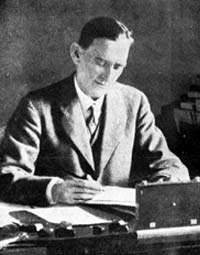John Marshall (archaeologist)
| John Marshall | |
|---|---|
 | |
| Born |
19 March 1876 Chester |
| Died |
17 August 1958 (aged 82) Guildford |
| Citizenship | British |
| Nationality | British |
| Fields | History, Archaeology |
| Institutions | Archaeological Survey of India |
| Known for | excavations in Harappa, Mohenjodaro, Sanchi, Sarnath, Taxila, Crete and Knossos |
| Influences | James Prinsep, H. H. Wilson, John Leyden, Henry Thomas Colebrooke, Colin Mackenzie and William Jones |
| Notable awards | Knighthood (1914) |
sir Sir John Hubert Marshall, CIE (19 March 1876, Chester, England – 17 August 1958, Guildford, England) was the Director-General of the Archaeological Survey of India from 1902 to 1928. He was responsible for the excavation that led to the discovery of Harappa and Mohenjodaro, two of the main cities that comprise the Indus Valley Civilization.
Personal history and career
Marshall was educated at Dulwich College as well as King's College, Cambridge.[1] In 1902 he was appointed Director-General of Archaeology by Lord Curzon within the British Indian administration, and modernised the approach to archaeology on that continent, introducing a programme of cataloguing and conservation of ancient monuments and artefacts.
It was thanks to Marshall that Indians were allowed for the first time to participate in excavations in their own country. In 1913, he began the excavations at Taxila, which lasted for twenty years. He laid the foundation stone for the Taxila museum in 1918. The museum hosts many artifacts and also hosts one of Marshall's very few portraits. He then moved on to other sites, including the Buddhist centres of Sanchi and Sarnath. His work revealed to the world the true age of Indian civilisation especially Indus Valley Civilization and Mauryan age (Ashoka's Age). Marshall also led excavations at the prehistoric Sohr Damb mound near Nal in Baluchistan - a small representative collection of pottery vessels from the site is now in the British Museum.[2] He is also known for his important part in excavations at Knossos and various other sites on Crete between 1898 and 1901 .
Marshall was appointed a Companion of the Order of the Indian Empire (CIE) in June 1910[3] and knighted in January 1915.[4]
Publications
- Marshall, John (ed.) (1931). Mohenjo-Daro and the Indus Civilization.
- Marshall, John H. (1960). The Buddhist Art of Gandhara: the Story of the Early School, Its Birth, Growth and Decline. Cambridge: Cambridge University Press.
- Marshall, John H. (1960). A Guide to Taxila (4th ed.). Cambridge: Cambridge University Press. External link in
|title=(help) - Marshall, John H.; M. B. Garde (1927). The Bagh Caves in the Gwalior State. London: The India Society.
- Marshall, John H.; Foucher, Alfred. The Monuments of Sanchi (3 vol.).
- Marshall, John H. (1918). A Guide to Sanchi. Calcutta: Superintendent, Government Printing.
In British Academy
Sir John Marshall was elected a Fellow of the British Academy in 1936 .
See also
References
- ↑ "Marshall, John Hubert (MRSL895JH)". A Cambridge Alumni Database. University of Cambridge.
- ↑ British Museum Collection
- ↑ London Gazette, 23 June 1910
- ↑ London Gazette, 9 March 1915
External links
| Preceded by James Burgess |
Director General of the Archaeological Survey of India 1902 - 1928 |
Succeeded by Harold Hargreaves |